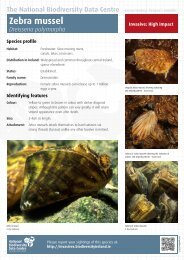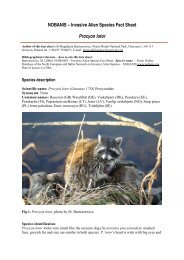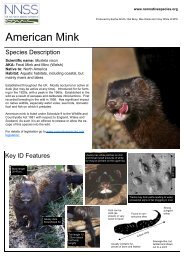Problematic Plant Species : Top 39 - National Invasive Species ...
Problematic Plant Species : Top 39 - National Invasive Species ...
Problematic Plant Species : Top 39 - National Invasive Species ...
You also want an ePaper? Increase the reach of your titles
YUMPU automatically turns print PDFs into web optimized ePapers that Google loves.
Azolla fi liculoides<br />
Crassula helmsii<br />
Lagarosiphon major<br />
Elodea canadensis<br />
© Paul Green<br />
Hydrocotyle ranunculoides<br />
Lemna minuta<br />
© Paul Green<br />
Lysichiton americanus<br />
© Paul Green<br />
Myriophyllum aquaticum<br />
© Paul Green<br />
<strong>Problematic</strong> Aquatic <strong>Species</strong><br />
The introduction of non-native invasive species is now a major cause of species extinction in freshwater systems<br />
(Millennium Ecosystem Assessment, 2005).<br />
Scientifi c Name Common Name<br />
Aponogeton distachyos Cape-pondweed<br />
Azolla fi liculoides Water Fern<br />
Ceratophyllum submersum Soft Hornwort<br />
Crassula helmsii New Zealand Pigmyweed<br />
Egeria densa South American Waterweed<br />
Elodea canadensis* Canadian Waterweed<br />
Elodea nutallii Nutall’s Waterweed<br />
Hottonia palustris Water-violet<br />
Hydrocotyle ranunculoides Floating Pennywort<br />
Lagarospiphon major Curly Waterweed<br />
Lemna minuta Least Duckweed<br />
Lysichiton americanus Yellow Skunk-cabbage<br />
Myriophyllum aquaticum Parrot’s-feather<br />
Nymphoides peltata Fringed water-lily<br />
Sagittaria rigida Canadian Arrowhead<br />
Table 2: <strong>Problematic</strong> aquatic plant species<br />
Submitting a record<br />
Accepted records must meet data standards defi ned by the <strong>National</strong> Biodiversity Data Centre. The mandatory<br />
list below is the minimal information that constitutes a valid biological record. Any additional information may<br />
also be submitted.<br />
Data item Description<br />
Taxon name The scientifi c name of the recorded taxon. An authority is not required but if available please supply<br />
this.<br />
Grid reference A six-fi gure grid reference, employing three digits in each coordinate, to determine a 100 m square. The<br />
preferred format is: <br />
Example: M518152 The minimum legal value is a tetrad: 2km x 2km square. When recording on private<br />
land please ensure permission has been obtained.<br />
Location A description of where the organism was observed. For example: “A kilometre north of Maam Cross”.<br />
Date The date that the observation was recorded. The following date format is preferable: dd/mm/yyyy.<br />
The minimum legal value is the year.<br />
Recorder The name of the person(s) that made the observation.<br />
Determiner Who verifi ed the identifi cation of the organism?<br />
When submitting aquatic invasive records it would be very valuable to include whether the species was recorded in a<br />
natural or man-made area and in a connected or isolated aquatic system. Records can be submitted through the <strong>National</strong><br />
Biodiversity Data Centre website: www.biodiversityireland.ie If you have any queries please contact either Dr. Una<br />
Fitzpatrick, Project Manager, email: ufi tzpatrick@biodiversityireland.ie or Colette O’ Flynn, Research Offi cer, e-mail<br />
cofl ynn@biodiversityireland.ie, <strong>National</strong> Biodiversity Data Centre, Beechfi eld House, WIT West Campus, Carriganore,<br />
Waterford. Phone: (051) 306240. Records may also be submitted through the ISI website: www.invasivespeciesireland.<br />
com/sighting/ Both websites have the Data Centres Excel template fi le for download and submission.<br />
For more information on invasive species and submitting records please visit<br />
the Data Centre’s website: www.biodiversityireland.ie<br />
<strong>National</strong> <strong>Invasive</strong><br />
<strong>Species</strong> Database<br />
PROBLEMATIC PLANT SPECIES
<strong>National</strong> <strong>Invasive</strong> <strong>Species</strong> Database<br />
<strong>Problematic</strong> <strong>Plant</strong> <strong>Species</strong> : <strong>Top</strong> <strong>39</strong><br />
<strong>Invasive</strong> alien plant species are species that have been introduced, generally by<br />
human intervention, outside their natural range and whose establishment and spread<br />
can threaten native ecosystem structure, function and delivery of services. Once<br />
introduced, control, management, and eradication where possible, of invasive species<br />
can be very diffi cult and costly; therefore early detection and reactive measures<br />
are desirable. Currently invasive species records are not centrally maintained. In<br />
response to this, the <strong>National</strong> Biodiversity Data Centre has established a <strong>National</strong><br />
<strong>Invasive</strong> <strong>Species</strong> Database that will provide centralised up-to-date information on<br />
the distribution of invasive species in Ireland. This database will play a key role in<br />
recording, monitoring and surveillance programs.<br />
Once a valid biological record is received it will be publically displayed on the <strong>National</strong><br />
Biodiversity Data Centre’s web GIS mapping system. For every additional record that<br />
is submitted, a clearer picture of the status of that invasive species in Ireland is<br />
generated. Display of such data against the backdrop of additional GIS layers will<br />
greatly enhance the information available to those involved in combating the threat<br />
of invasive species in Ireland. The <strong>39</strong> species listed in this booklet are the initial focus<br />
of record collection in the establishment phase of the database.<br />
Why these <strong>Top</strong> <strong>39</strong>?<br />
This list includes species which are not extremely widespread but which are<br />
considered a problem or a potential problem in Ireland. This list was initially<br />
compiled by Sylvia Reynolds in June 2007 and was agreed by Dr. Matthew Jebb<br />
of the <strong>National</strong> Botanic Gardens. An additional seven more widespread<br />
species (*) have been added to ensure overlap with the plant species<br />
recognised by the <strong>Invasive</strong> <strong>Species</strong> Ireland project as Ireland’s<br />
most unwanted invasives. The inclusion of Cotoneaster<br />
integrifolius is based on the recommendation of the<br />
Clare Biodiversity Group.<br />
<strong>Problematic</strong> Terrestrial <strong>Species</strong><br />
Scientifi c name Common name Habitat recorded in<br />
Acaena anserinifolia Bronze Pirri-pirri-bur Gardens and rockery.<br />
Acaena novae-zelandiae Pirri-pirri-bur<br />
Acaena ovalifolia Two-spined Acaena<br />
Carpobrotus edulis Hottentot-fi g Coastal cliffs, rocks, sand.<br />
Cotoneaster integrifolius<br />
Entire-leaved<br />
Cotoneaster<br />
Wet slopes, castle gardens, rough pastures, grassy areas and<br />
woods.<br />
Demesne woodlands, roadsides, by streams, sandstone quarry<br />
and lowland pasture.<br />
Rocky substrates, walls, lakeshores, roadsides, railway banks,<br />
sand dunes, woodland and urban habitats.<br />
Cyperus eragrostis Pale Galingale Waste ground, rock outcrops, gravel shores, and roadsides.<br />
Fallopia japonica* Japanese Knotweed<br />
Demesnes, parks, river banks, roadsides, waste ground,<br />
rubbish tips and coastal islands.<br />
Gaultheria mucronata Prickly Heath Acid soils, moorland, woodland, quarries and coastal habitats<br />
Gaultheria shallon Shallon Parks and demesnes.<br />
Gunnera tinctoria* Giant-rhubarb<br />
Heracleum<br />
mantegazzianum*<br />
Giant Hogweed<br />
Impatiens glandulifera* Indian Balsam<br />
Juncus planifolius Broad-leaved Rush<br />
Lagarus ovatus Hare’s-tail Sandy beaches<br />
Boggy ground, damp pastures, ditches, roadsides and by<br />
streams.<br />
Damp ground along rivers and streams, roadsides, waste<br />
ground, walls, rubbish tips<br />
Damp ground, along rivers, streams and lake margins,<br />
roadsides and waste ground.<br />
Damp habitats, peaty and mineral soils, by streams, on lake<br />
shores and marshy meadows.<br />
Libertia formosa Chilean-iris Lake shores, along rivers and coastal cliffs.<br />
Phormium tenax New Zealand Flax<br />
Rhododendron ponticum* Rhododendron<br />
Coastal habitats, on cliffs, waste ground, in dunes, damp<br />
ground and by streams.<br />
Drier lowland, upland bogs, rocky slopes, native and demesne<br />
woodlands.<br />
Rubus spectabilis Salmonberry Woodland, open ground, neglected gardens, and hedgerows.<br />
Sarracenia purpurea Pitcherplant Bogs<br />
Sasa palmata<br />
Broad-leaved<br />
Bamboo<br />
Parks, demesnes and stream sides.<br />
Senecio cineraria Silver Ragwort Cliffs, walls, railway banks and mainly coastal sites.<br />
Sisyrinchium californicum Yellow-eyed-grass Marshy meadows, lake shores, damp grassland and ditches.<br />
Spartina anglica* Common Cord-grass Intertidal mud fl ats<br />
Stratiotes aloides Water-soldier Lakes, ditches and canals.<br />
Table 1: <strong>Problematic</strong> terrestrial plant species<br />
Information from the Habitat recorded in column, was obtained from Reynolds, S.C.P. (2002) A catalogue<br />
of alien plants in Ireland. <strong>National</strong> Botanic Gardens, Glasnevin, Ireland.<br />
Additional information on many of the <strong>Top</strong> <strong>39</strong> species in this booklet can be found on the <strong>Invasive</strong> <strong>Species</strong><br />
Ireland website: www.invasivespeciesireland.com which also has a colourful ‘Field Guide to <strong>Invasive</strong><br />
<strong>Species</strong> in Ireland’ available for download.





